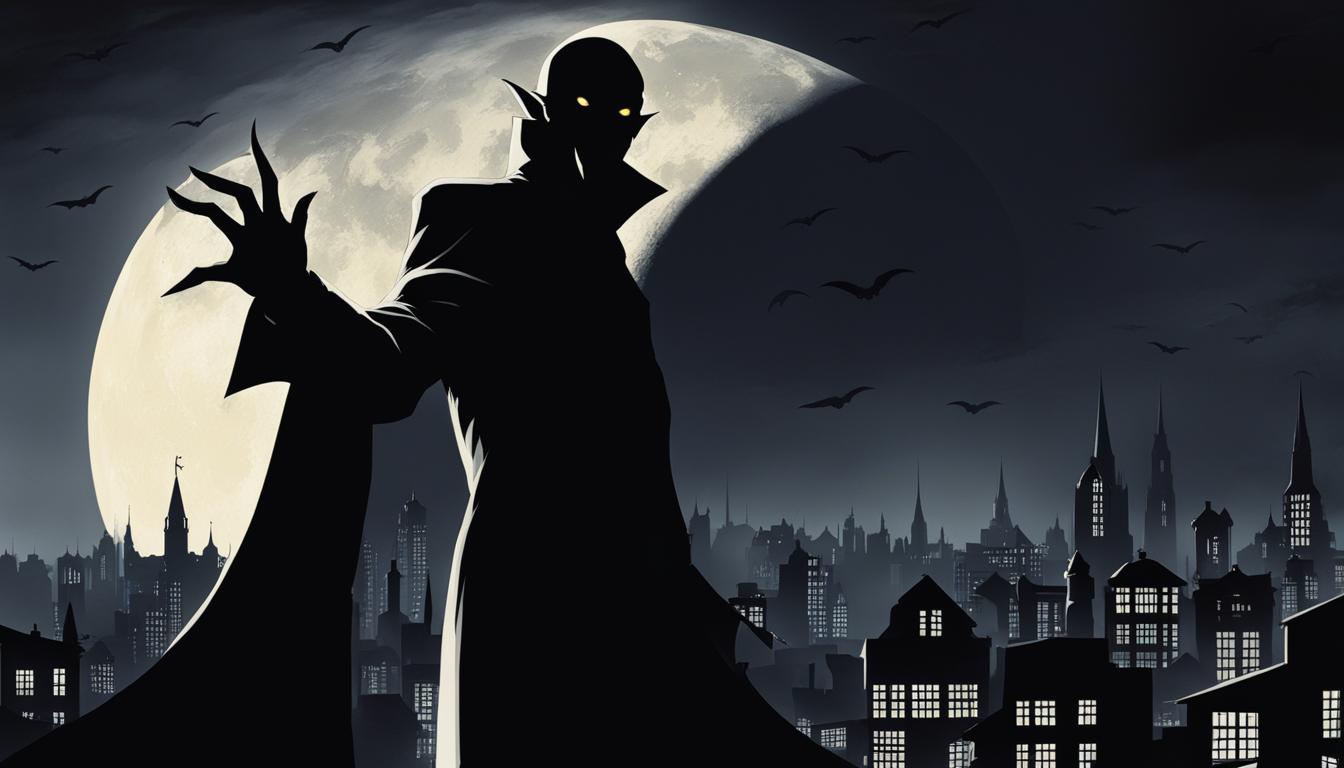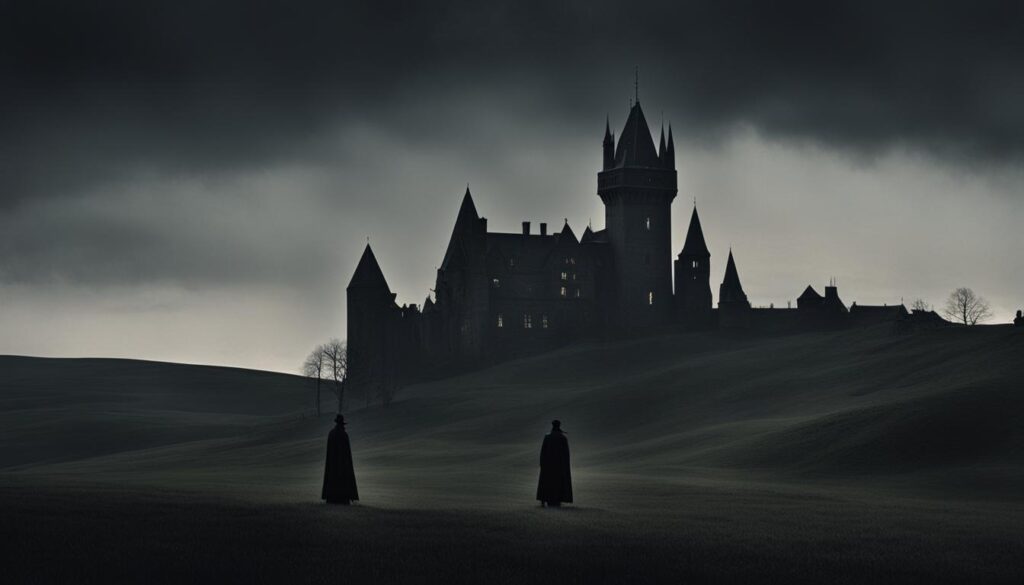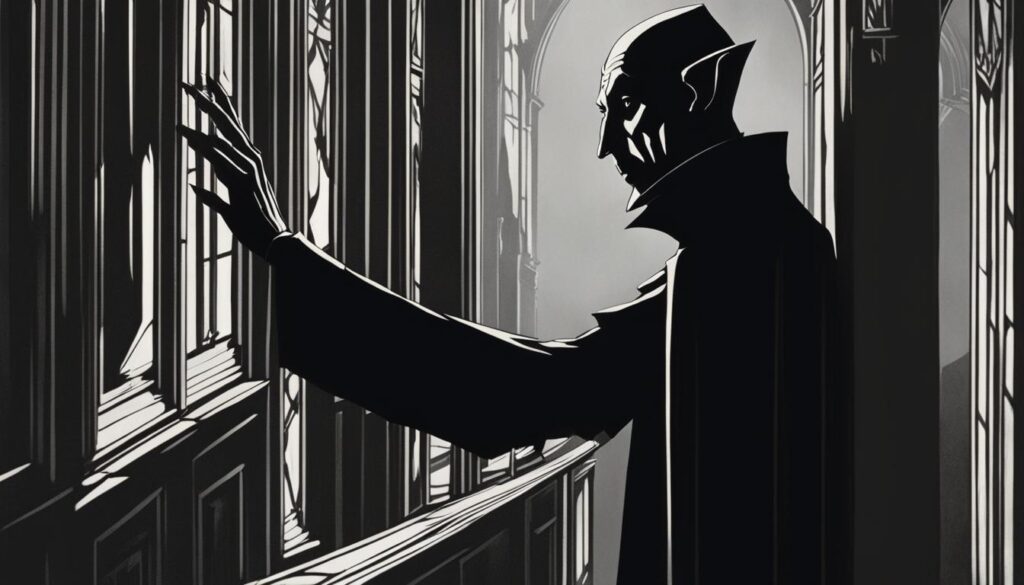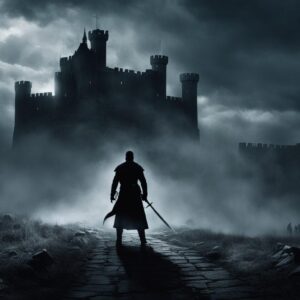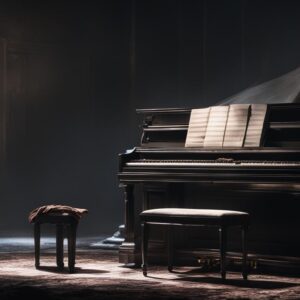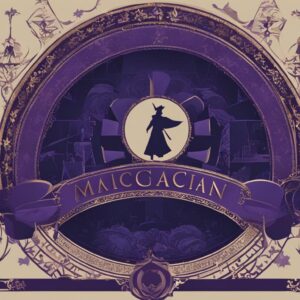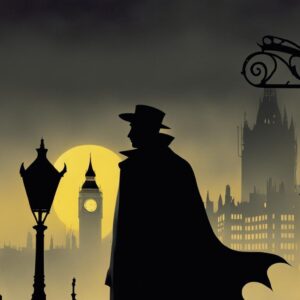As a film enthusiast, I have always been fascinated by the magic of the silent era. One movie that stands out from this golden age of cinema is “Nosferatu” (1922). This German expressionist vampire film, directed by F.W. Murnau, continues to mesmerize audiences with its haunting atmosphere and timeless appeal.
Starring Max Schreck as Count Orlok, “Nosferatu” is a classic horror masterpiece that has left an indelible mark on the genre. Its unique blend of German expressionism and vampire mythology creates an eerie and chilling experience that has stood the test of time.
Key Takeaways:
- “Nosferatu” (1922) is a silent film considered a masterpiece from the silent film era.
- Directed by F.W. Murnau and starring Max Schreck, it is a German expressionist vampire movie that has become an iconic classic in the horror cinema.
- The film is based on Bram Stoker’s novel “Dracula,” but due to copyright issues, the names and title were changed.
- Max Schreck’s portrayal of Count Orlok is a terrifying and unforgettable performance that has influenced the portrayal of vampires in horror cinema.
- “Nosferatu” (1922) has had a profound influence on the horror genre and vampire movies in particular, inspiring numerous adaptations.
The Chilling Allure of Nosferatu (1922)
“Nosferatu” (1922) is a silent film that captivates viewers with its chilling allure. The film is a prime example of German expressionism and is considered a classic in the horror genre. Directed by F.W. Murnau and featuring an unforgettable performance by Max Schreck as Count Orlok, the movie continues to fascinate audiences with its eerie atmosphere and haunting images.
The visual style of “Nosferatu” is a key element that contributes to its enduring appeal. The film’s use of German expressionism creates a sense of unease and dread, with its exaggerated and distorted set designs and atmospheric lighting. The cinematography, with its innovative use of shadows and unconventional framing, adds to the film’s eerie atmosphere, immersing viewers in the world of the undead.
The iconic portrayal of Count Orlok by Max Schreck is another aspect that sets “Nosferatu” apart. Schreck’s performance, with his menacing appearance and animalistic movements, instills a sense of terror in the audience. His portrayal of the vampire as a cursed creature trapped between the realms of the living and the undead has become the standard in vampire depictions within the horror genre.
The lasting influence and significance of “Nosferatu” can be seen in the numerous Dracula adaptations that followed. While many have tried to capture the essence and artistry of Murnau’s film, none have been able to replicate its chilling allure. “Nosferatu” remains a timeless classic that continues to captivate audiences with its haunting beauty and serves as a testament to the power of silent storytelling and the enduring appeal of horror cinema.
The Story Behind Nosferatu (1922)
Nosferatu (1922) is a silent film based on Bram Stoker’s novel “Dracula.” However, due to copyright issues, the names and title were changed. The film’s production faced legal challenges from Stoker’s widow, Florence Balcombe, resulting in attempts to destroy all copies of the film. Fortunately, some copies were saved, and the movie survived to become a landmark in German cinema and inspire numerous future Dracula adaptations.
Directed by F.W. Murnau and starring Max Schreck as the iconic vampire Count Orlok, Nosferatu (1922) tells a haunting tale that continues to captivate audiences. While the film deviates from Stoker’s original story, it retains the essence of the vampire mythos, portraying Count Orlok as a sinister and menacing creature that preys upon the living.
The legal issues surrounding Nosferatu (1922) speak to the film’s controversial nature. The unauthorized adaptation of Stoker’s work resulted in legal action that ultimately blocked the film from widespread distribution. However, the attempts to suppress the movie only heightened its notoriety and contributed to its enduring legacy.
The Legacy of Nosferatu (1922)
The legacy of Nosferatu (1922) extends beyond its legal battles. It remains a testament to the artistic and technical achievements of German expressionism, characterized by its exaggerated and stylized visuals. The film’s influence can be seen in subsequent vampire movies and horror films, as well as the broader realm of cinema.
Despite its troubled history, Nosferatu (1922) has stood the test of time and continues to be celebrated for its atmospheric storytelling, innovative visuals, and unforgettable performance by Max Schreck. It remains a significant landmark in cinema history and a must-watch for fans of the horror genre.
| German Expressionism | Vampire Mythos | Cultural Impact |
|---|---|---|
| Nosferatu (1922) embodies the aesthetic principles of German expressionism, which sought to convey deep emotions and psychological states through exaggerated visuals. | The film’s portrayal of Count Orlok as a vampire helped solidify key elements of vampire lore, including immortality, fear of sunlight, and the ability to transform into a bat. | Nosferatu (1922) has left an indelible mark on popular culture, inspiring countless adaptations and contributing to the enduring fascination with vampires in literature, film, and other forms of media. |
| Influence on Horror Genre | Legal Controversy | Artistic Achievement |
| The film’s unique blend of horror and artistry set a new standard for the horror genre, influencing future filmmakers and shaping the visual language of horror cinema. | The legal battles surrounding Nosferatu (1922) highlighted the challenges of adapting existing works and sparked discussions on copyright laws and artistic freedom. | Nosferatu (1922) is recognized for its innovative cinematography, atmospheric set designs, and Max Schreck’s outstanding performance, cementing its status as a work of art. |
The Terrifying Performance of Max Schreck
When it comes to portraying the iconic vampire Count Orlok in “Nosferatu” (1922), Max Schreck’s performance is nothing short of terrifying. Schreck’s portrayal of the vampire is a masterclass in creating horror and unease. With his ghastly appearance and haunting presence, he immerses viewers in a world of fear and dread.
“I have seen the horror. Horrors have not crept into dungeons. They have always been there, only now we know. We know because we have seen them.” – Max Schreck
Schreck’s physical transformation into Count Orlok is truly remarkable. His makeup, featuring bat-like ears, claw-like nails, and rodent-like fangs, adds a chilling authenticity to the character. Through his haunting gaze and subtle movements, Schreck embodies the animalistic nature of the vampire, instilling a deep sense of fear in the audience.
Max Schreck’s portrayal of Count Orlok in “Nosferatu” has left an indelible mark on the portrayal of vampires in horror cinema. His mesmerizing performance set the standard for future vampire portrayals, influencing countless actors and filmmakers. Even after almost a century, Schreck’s terrifying depiction of the vampire continues to captivate and terrify audiences.
| Aspect | Description |
|---|---|
| Appearance | Schreck’s makeup and costume create a haunting and otherworldly look for Count Orlok, enhancing the film’s atmosphere. |
| Physicality | Schreck’s subtle movements and eerie demeanor give Count Orlok an animalistic quality, making him all the more terrifying. |
| Impact | Schreck’s performance in “Nosferatu” has had a lasting influence on vampire portrayals in the horror genre, cementing his legacy as one of the most iconic vampires in film history. |
The Influence of Nosferatu (1922)
The silent film “Nosferatu” (1922) has had a profound influence on the horror genre and vampire movies in particular. Its unique blend of German expressionism, chilling atmosphere, and unforgettable characters continues to inspire filmmakers to this day. No other Dracula adaptation has been able to capture the same artistic essence and enduring impact as F.W. Murnau’s original masterpiece.
One notable attempt to pay homage to “Nosferatu” is Werner Herzog’s 1979 version, starring Klaus Kinski as the vampire Count. While Herzog’s adaptation came close to capturing the spirit of the original, it is undeniable that “Nosferatu” remains the seminal work that set the standards for future vampire films. Its influence can be seen in the visual style, storytelling techniques, and even the portrayal of vampires in cinema.
“Nosferatu” (1922) paved the way for countless Dracula adaptations and established the vampire as a timeless and iconic figure in horror cinema. Its haunting imagery and eerie atmosphere have become synonymous with the genre itself.”
The enduring legacy of “Nosferatu” can also be seen in its impact on German expressionism, a movement that sought to depict the inner emotions and psychological states of characters through visual imagery. The film’s use of shadows, unconventional framing, and distorted sets contributed to the creation of a nightmarish world that has captivated audiences for over a century.
| Aspect | Influence |
|---|---|
| Visual Style | Established the use of shadows, unconventional framing, and distorted sets in horror cinema |
| Storytelling Techniques | Inspired future filmmakers to experiment with non-linear narratives and atmospheric storytelling |
| Vampire Portrayal | Shaped the iconic image of the vampire as a menacing, animalistic creature |
In conclusion, “Nosferatu” (1922) is a cinematic masterpiece that continues to influence the horror genre and vampire movies. Its lasting impact can be seen in the visual style, storytelling techniques, and portrayal of vampires in cinema. F.W. Murnau’s visionary direction and the unforgettable performances of the cast have solidified the film’s place in history and ensured its status as a timeless classic.
The Visual Style of Nosferatu (1922)
“Nosferatu” (1922) is renowned for its visually striking and atmospheric style. F.W. Murnau’s use of German expressionism creates a sense of unease and dread throughout the film. The cinematography, with its use of shadows and unconventional framing, adds to the film’s eerie atmosphere. The unique visual style of “Nosferatu” sets it apart from other movies of its time and contributes to its lasting impact.
The film’s visuals are characterized by stark contrasts between light and shadow, creating a haunting ambiance that envelops the audience. The use of dark, ominous shadows and exaggerated, angular set designs enhances the sense of unease and contributes to the overall Gothic aesthetic. Murnau’s attention to detail is evident in every frame, as he meticulously crafts each shot to evoke a specific emotion or convey a particular message.
One of the most memorable visual elements of the film is the portrayal of Count Orlok, played by Max Schreck. With his grotesque appearance and eerie movements, Schreck’s portrayal of the vampire embodies the essence of horror. The use of makeup and prosthetics to transform Schreck into Orlok is a testament to the dedication of the filmmakers in creating a truly terrifying character.
| Visual Elements | Description |
|---|---|
| Shadows | The film uses shadows to create a sense of mystery and suspense. Dark, looming shadows are used to symbolize the presence of evil and heighten the audience’s sense of fear. |
| Set Design | The angular and surreal set designs contribute to the film’s expressionistic style. The distorted architecture adds to the overall sense of unease and reflects the psychological themes of the narrative. |
| Character Design | The makeup and prosthetics used to transform Max Schreck into Count Orlok give the vampire a truly monstrous appearance. The design is both unsettling and iconic, solidifying Orlok’s place in horror cinema history. |
“Nosferatu” (1922) is a visually captivating masterpiece that continues to inspire filmmakers and artists today. Its innovative use of German expressionism and attention to detail in its visuals make it a standout in the history of cinema. The film’s haunting atmosphere and iconic character design have left an indelible mark on the horror genre, making it a must-watch for any cinephile.
The Legacy of Nosferatu (1922)
Nosferatu (1922) left a lasting legacy in the world of cinema. It is regarded as a pioneering work in the horror genre and a prime example of German expressionism. The film’s influence can be seen in the visual style and storytelling techniques of subsequent horror movies. Even after 100 years, Nosferatu continues to captivate viewers and inspire filmmakers.
One of the key aspects of Nosferatu’s legacy is its impact on vampire movies. The portrayal of Count Orlok by Max Schreck introduced a new level of terror and eeriness to the vampire archetype. Schreck’s animalistic appearance and chilling performance set the standard for future interpretations of vampires in horror cinema. From Bela Lugosi’s iconic portrayal in the 1931 film adaptation of Dracula to modern interpretations like Gary Oldman in Bram Stoker’s Dracula (1992), the influence of Nosferatu can be seen in the way vampires are portrayed on screen.
Nosferatu also paved the way for the use of visual storytelling techniques in horror films. F.W. Murnau’s innovative use of German expressionism created a visual style that evoked a sense of unease and dread. The use of shadows, unconventional framing, and exaggerated sets added to the atmospheric and haunting nature of the film. This visual approach has inspired countless filmmakers, influencing the aesthetics of horror movies to this day.
The Legacy of Nosferatu in Table Format
| Aspect | Impact |
|---|---|
| Vampire Movies | Introduced a new level of terror and eeriness to the vampire archetype, influencing future portrayals in horror cinema. |
| Visual Storytelling | Pioneered the use of German expressionism and innovative cinematography techniques, inspiring the visual aesthetics of horror films. |
| Influence on Filmmakers | Continues to inspire filmmakers and serve as a reference for the horror genre, shaping the way stories are told on screen. |
In conclusion, Nosferatu (1922) has left an indelible mark on the world of cinema. Its influence can be seen in the portrayal of vampires, the use of visual storytelling techniques, and its lasting impact on filmmakers. As a pioneering work in the horror genre and a prime example of German expressionism, the legacy of Nosferatu continues to captivate and inspire audiences even after a century.
The Timeless Appeal of Nosferatu (1922)
Despite being a silent film from 1922, Nosferatu has a timeless appeal that still resonates with modern audiences. Its combination of stunning visuals, atmospheric storytelling, and Max Schreck’s iconic portrayal of Count Orlok ensures that the film remains a captivating cinematic experience. Whether watching it for the first time or revisiting it, Nosferatu continues to enthrall viewers with its haunting beauty.
The film’s use of German expressionism creates a sense of unease and dread that transcends time and language. The stark contrast of light and shadow, along with the distorted sets and exaggerated angles, adds to the film’s eerie atmosphere. Director F.W. Murnau’s meticulous attention to detail, coupled with the hauntingly beautiful cinematography, transports audiences into a world of horror and suspense.
Max Schreck’s portrayal of Count Orlok is a masterclass in silent film acting. His physical transformation into the vampire is both mesmerizing and terrifying, with his grotesque features and predatory movements leaving a lasting impression on viewers. Schreck’s ability to convey emotion and menace without uttering a single word showcases the power of silent storytelling and the impact it can have on an audience.
“Nosferatu is a dark and atmospheric masterpiece that continues to captivate viewers with its eerie beauty and haunting imagery.” – Film Critic
Despite the passage of time and advancements in film technology, Nosferatu remains a testament to the enduring power of classic horror. Its ability to evoke fear and suspense without relying on dialogue or special effects sets it apart from contemporary vampire movies. The timeless appeal of Nosferatu lies not only in its status as a groundbreaking silent film but also in its ability to tap into the universal human fascination with the macabre.
| Key Aspects | Description |
|---|---|
| Genre | Classic Horror |
| Director | F.W. Murnau |
| Lead Actor | Max Schreck |
| Style | German Expressionism |
| Release Year | 1922 |
The Artistic Achievement of Nosferatu (1922)
“Nosferatu” (1922) is not just a horror movie; it is an artistic achievement. F.W. Murnau’s direction, combined with the cinematography, sets, and Max Schreck’s performance, elevates the film to a level of artistry rarely seen in the genre. The movie’s ability to create a sense of dread and unease through its visuals and storytelling is a testament to its enduring impact on cinema.
“Nosferatu” showcases the power of silent storytelling and the innovative use of German expressionism. Murnau’s meticulous attention to detail is evident in every frame, with each shot carefully crafted to evoke emotion and heighten the sense of horror. The use of shadows, distorted angles, and haunting imagery creates a visual feast for the eyes and adds depth to the narrative.
The film’s artistic quality is further enhanced by Max Schreck’s unforgettable portrayal of Count Orlok. His physical transformation into the vampire is a testament to his commitment to the role, and his performance exudes a haunting presence that lingers long after the movie ends. Schreck’s ability to convey both the animalistic nature and the underlying tragedy of the character adds a layer of complexity to the film.
The Visual Mastery of German Expressionism
The artistic achievement of “Nosferatu” lies in its masterful execution of German expressionism. This avant-garde artistic movement sought to convey emotions and inner truths through distorted visuals and exaggerated imagery. Murnau’s expert use of this style elevates the film beyond a simple horror story, transforming it into a visual masterpiece.
The iconic scenes of Count Orlok’s shadowy figure ascending the stairs or peering out from behind a curtain are not just chilling moments, but intentional artistic choices that evoke a sense of unease and vulnerability. The cinematography, combined with the expressionistic set designs, creates an otherworldly atmosphere that immerses the viewer in the terrifying world of the vampire.
The Lasting Impact on Cinema
The artistic achievements of “Nosferatu” have left a lasting impact on the world of cinema. Its innovative use of visual storytelling and its ability to evoke emotions through striking imagery have influenced countless filmmakers and continue to inspire new generations of artists. The film’s enduring status as a classic of silent cinema and horror genre highlights its significance in the history of film artistry.
| Artistic Aspects | Description |
|---|---|
| Cinematography | Murnau’s use of shadows, unconventional framing, and distorted angles creates a visually striking film that adds to the overall atmosphere and sense of dread. |
| Set Designs | The expressionistic set designs contribute to the film’s otherworldly and eerie atmosphere, transporting viewers into the nightmarish world of Count Orlok. |
| Max Schreck’s Performance | Schreck’s portrayal of Count Orlok is a masterclass in physical transformation and character work, adding depth and complexity to the film. |
The Enduring Significance of Nosferatu (1922)
“Nosferatu” (1922) holds a special place in the world of cinema as a silent film that continues to captivate audiences with its timeless appeal. This German expressionist vampire movie, directed by F.W. Murnau, has left an indelible mark on the horror genre and is regarded as a masterpiece in horror cinema.
The film’s enduring significance lies in its innovative use of German expressionism, which creates a sense of unease and dread throughout. Murnau’s visionary direction, combined with the atmospheric storytelling and haunting visuals, sets “Nosferatu” apart from other movies of its time.
Max Schreck’s iconic portrayal of Count Orlok adds to the film’s enduring appeal. With his menacing appearance and animalistic portrayal, Schreck’s performance has become synonymous with the character of a vampire.
“Nosferatu” continues to be significant in the world of cinema for its contribution to the horror genre and its innovative use of German expressionism.
The lasting impact of “Nosferatu” can be seen in its influence on subsequent vampire movies and horror films. It has inspired countless adaptations of Bram Stoker’s “Dracula” and has served as a benchmark for filmmakers seeking to capture the same artistic quality and atmospheric storytelling.
As a landmark in German cinema and a masterpiece of silent film, “Nosferatu” remains a timeless classic that celebrates the power of visual storytelling and continues to captivate viewers, making it a must-watch for fans of the horror genre and cinema enthusiasts alike.
Conclusion
As I conclude this exploration of “Nosferatu” (1922), I am reminded of the enduring legacy and timeless appeal of this silent film masterpiece. From its chilling allure to its unique German expressionist style, the movie continues to enthrall audiences with its haunting beauty.
Director F.W. Murnau’s visionary direction and Max Schreck’s unforgettable performance as Count Orlok have solidified “Nosferatu” as a classic in the horror genre. The film’s ability to create a sense of dread and unease through its atmospheric storytelling and stunning visuals is a testament to its enduring impact on cinema.
“Nosferatu” (1922) stands as a testament to the power of silent storytelling and the artistry of German expressionism. Its contribution to the horror genre and its lasting influence on subsequent vampire movies cannot be understated. Whether you are a fan of classic horror or simply appreciate the art of cinema, “Nosferatu” is a must-watch film that will continue to captivate audiences for years to come.
FAQ
What is “Nosferatu” (1922)?
“Nosferatu” (1922) is a silent film that is considered a masterpiece from the silent film era. It is a German expressionist vampire movie directed by F.W. Murnau and starring Max Schreck as Count Orlok. It has become an iconic classic in the horror cinema.
Is “Nosferatu” (1922) based on a novel?
Yes, “Nosferatu” (1922) is based on Bram Stoker’s novel “Dracula.” However, due to copyright issues, the names and title were changed. The film faced legal challenges from Stoker’s widow, resulting in attempts to destroy all copies. Some copies were saved, and the movie survived to become a landmark in German cinema and inspire future Dracula adaptations.
Who plays Count Orlok in “Nosferatu” (1922)?
Max Schreck delivers a remarkable and terrifying performance as Count Orlok. With his menacing appearance, including bat-like ears, claw-like nails, and rodent-like fangs, Schreck portrays the vampire as an animalistic creature suffering from a dreadful curse. His portrayal has left a lasting impact on the portrayal of vampires in horror cinema.
How has “Nosferatu” (1922) influenced the horror genre?
“Nosferatu” (1922) has had a profound influence on the horror genre and vampire movies in particular. It inspired dozens of Dracula adaptations that followed, but none were able to capture the same artistic and unforgettable essence as Murnau’s film. Werner Herzog’s 1979 version, starring Klaus Kinski, came closest to capturing the spirit of “Nosferatu,” but the original remains a seminal work in German cinema.
What is the visual style of “Nosferatu” (1922)?
“Nosferatu” (1922) is renowned for its visually striking and atmospheric style. F.W. Murnau’s use of German expressionism creates a sense of unease and dread throughout the film. The cinematography, with its use of shadows and unconventional framing, adds to the film’s eerie atmosphere. The unique visual style of “Nosferatu” sets it apart from other movies of its time and contributes to its lasting impact.
What is the legacy of “Nosferatu” (1922) in cinema?
“Nosferatu” (1922) left a lasting legacy in the world of cinema. It is regarded as a pioneering work in the horror genre and a prime example of German expressionism. The film’s influence can be seen in the visual style and storytelling techniques of subsequent horror movies. Even after 100 years, “Nosferatu” continues to captivate viewers and inspire filmmakers.
Why is “Nosferatu” (1922) considered a timeless classic?
Despite being a silent film from 1922, “Nosferatu” has a timeless appeal that still resonates with modern audiences. Its combination of stunning visuals, atmospheric storytelling, and Max Schreck’s iconic portrayal of Count Orlok ensures that the film remains a captivating cinematic experience. Whether watching it for the first time or revisiting it, “Nosferatu” continues to enthrall viewers with its haunting beauty.
What makes “Nosferatu” (1922) an artistic achievement?
“Nosferatu” (1922) is not just a horror movie; it is an artistic achievement. F.W. Murnau’s direction, combined with the cinematography, sets, and Max Schreck’s performance, elevates the film to a level of artistry rarely seen in the genre. The movie’s ability to create a sense of dread and unease through its visuals and storytelling is a testament to its enduring impact on cinema.
Why is “Nosferatu” (1922) significant in cinema?
“Nosferatu” (1922) continues to be significant in the world of cinema for its contribution to the horror genre and its innovative use of German expressionism. The film’s enduring popularity and critical acclaim demonstrate its lasting impact on audiences and filmmakers alike. As a landmark in German cinema and a masterpiece of silent film, “Nosferatu” remains a timeless classic that continues to be celebrated and studied.

